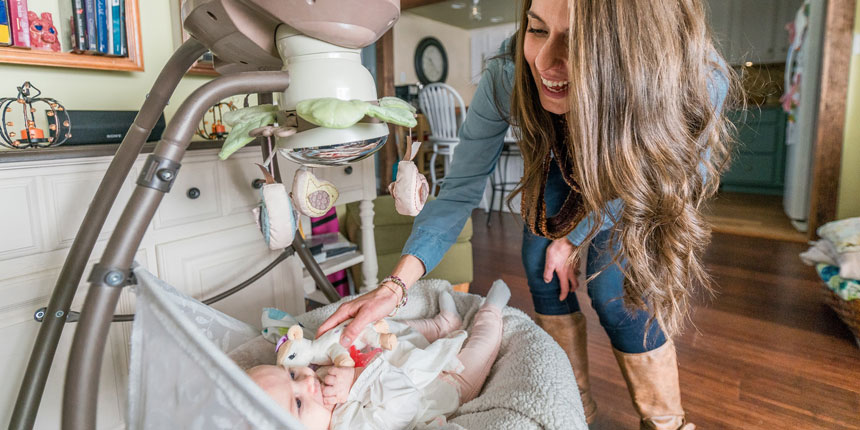Health+
Southcoast Makes C-Sections Gentler and More Family Focused

Two new maternity services keep families close to home and loved ones
Delivering a new life into this world is one of those wonderful moments that bring families together — from great-grandparents to neighbors who feel just like family. With this community spirit in mind, Southcoast Health has a history of expanding its maternity services to include procedures that previously required referring patients to larger teaching hospitals in Boston or Providence. “More than ever, our patients want their birthing process to be a family affair, and we’re doing everything possible to accommodate these expectations.” explains Dr. Michael A. Pepi, Southcoast’s chief of obstetrics and gynecology (OB/GYN).
Two such maternity services that keep parents close to home include the vaginal birth after cesarean (VBAC) and the gentle cesarean section (gentle C-section).
Gentle care
There are many reasons for a cesarean birth, or C-section, which can range from health and safety issues to the fact that the baby is too large for a vaginal birth. Regardless of the reason, a C-section is rarely what families expect. And it is surgery, so by definition “C-section” and “gentle” seem like an odd pairing.
At all three Southcoast Health hospitals, make every effort is made to blend these two seemingly incompatible concepts by offering the gentle C-section.
At its core, a gentle C-section embraces several benefits associated with a vaginal birth, such as immediately placing the baby on mom’s chest after delivery for skin-to-skin contact. This encourages mother-child bonding, helps regulate the baby’s body temperature and heart rate, and promotes successful breastfeeding.
“The key is to increase bonding between mother and child immediately after delivery,” Dr. Pepi says. “This is what’s missing after a traditional C-section, with the baby taken aside for assessment and the mother moved to a recovery room.”
What to expect
“A gentle C-section is like a carefully choreographed dance, and it takes additional medical support, which is often why community hospitals don’t offer this procedure,” explains Dr. Pepi.
The essential ways in which a gentle C-section differs from a traditional C-section include:
- EKG leads are moved to mom’s back rather than above her chest. This leaves space for a nurse to immediately place the newborn on the mother’s chest.
- The anesthesiologist monitors an epidural or spinal block, which prevents the mother from feeling pain but allows her to be fully conscious as her child is born.
- Mom always has one arm free from an intravenous line or other monitoring device, so she can snuggle her baby immediately after delivery.
- A clear drape is used during surgery, giving the family full view as the baby is lifted from the mother’s belly.
- While the doctor sutures the woman’s uterus and abdomen, a nurse immediately places the newborn on the mom’s chest.
- Rather than taking the baby aside, the pediatric team assesses the baby from the mother’s chest.
“I’ve heard a lot of positive feedback from both patients and physicians,” Dr. Pepi says. “This may still be surgery, but it’s a much warmer environment than the traditional operating room.”
A new view on VBAC
VBAC from Southcoast Health on Vimeo.
For many years, if you had a child by C-section, is it was not considered safe to deliver subsequent children vaginally. Today, that view is changing. Evidence-backed data has led the American Congress of Obstetricians and Gynecologists (ACOG) to estimate that 60 to 80 percent of women who have a VBAC will be successful.
This positive data, coupled with more women wanting VBAC, led Southcoast to introduce the delivery option at St. Luke’s Hospital in 2017. Dr. Pepi expects VBAC be available at more hospitals in 2018.
What to expect
The process begins with a highly individualized consultation, says Dr. G. Uma Harinarayanan, a Southcoast OB/GYN, who is known as Dr. Hari by her patients. “After obtaining a detailed medical history and obstetrical history, we will discuss benefits and risks of VBAC for each individual patient. As long mom and baby are healthy and safe, we will make every effort to give our patients the birth experience that they desire.”
From that initial consultation and on through mom’s due date, the Southcoast OB/GYN will be monitoring the following signs of progress:
- The pregnancy is progressing normally.
- Both mom and baby are in good health.
- The baby is average weight and not breech.
- The reason for the prior C-section does not reoccur.
- Labor begins naturally on or before the due date. If timing becomes an issue, a scheduled C-section may be necessary.
There’s a lot to consider, but it’s effort well spent, says Dr. Pepi. “We’ve had numerous success stories with VBAC, which makes our patients and obstetricians very happy.”
The VBAC and gentle C-section are two maternity services that prove Southcoast’s pledge to help families stay close to home throughout their birthing journey. “We’re focused on giving comprehensive women’s care and obstetrical care – from preconception to baby’s first year out,” Dr. Hari emphasizes. “If at all possible, that includes giving every woman the birth and postpartum experience she wants.”
Learn more about Southcoast’s maternity services.
